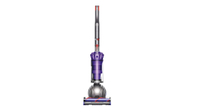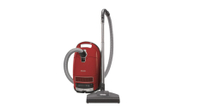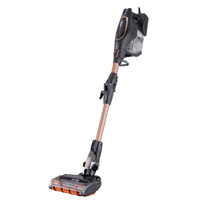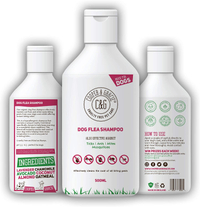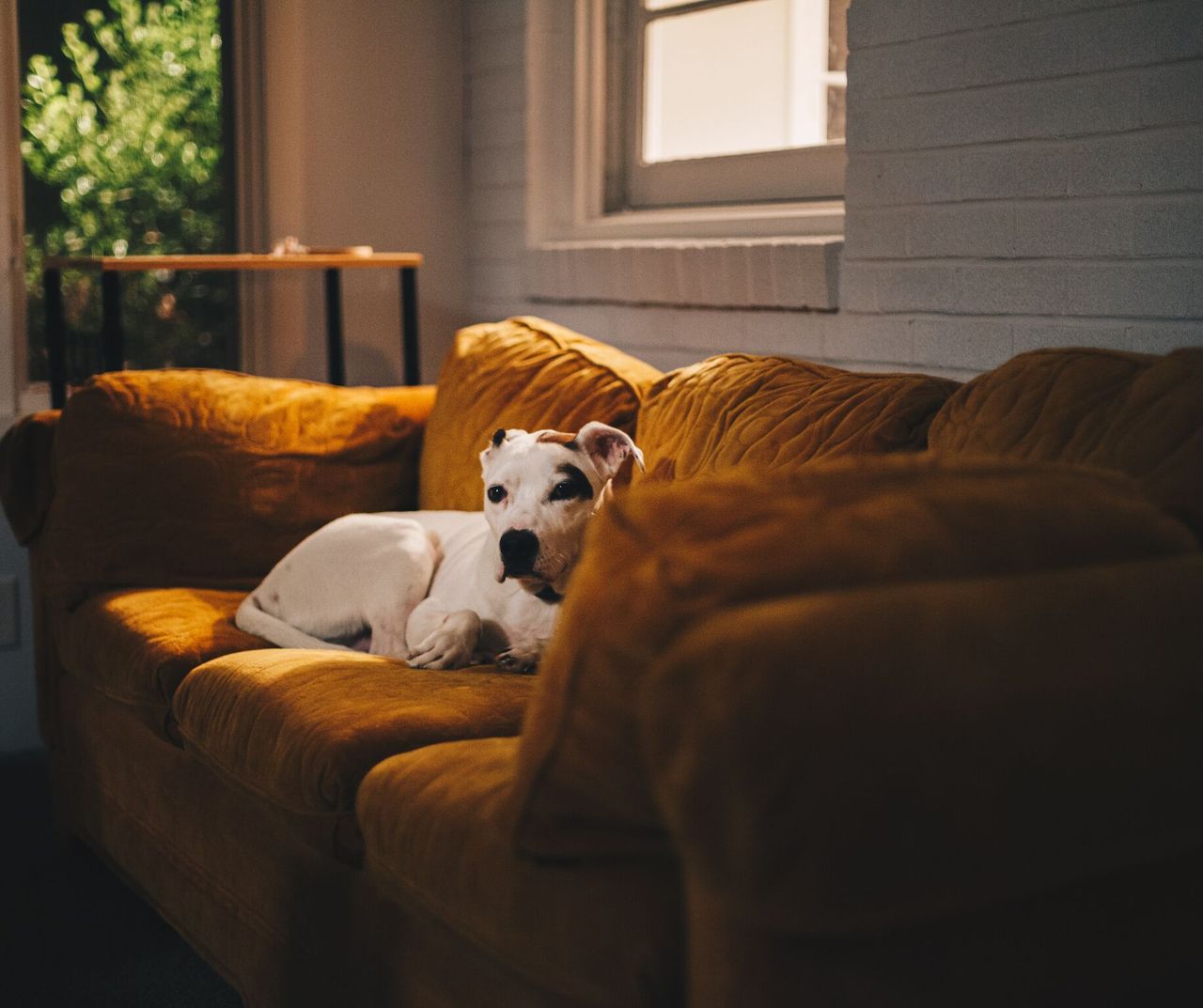

Need to know how to get rid of fleas? Usually brought into the house by your dog or cat, fleas feed on dirt and by sucking blood from animals and, sometimes, us humans. Their bites aren't harmful but they are itchy and annoying.
Fleas are black, and around 2.5mm long; and they can really jump – up to a metre high – which is when you'll have the best chance of spotting them.
If you're hunting about for them indoors – or perhaps in the garden – bear in mind that they like shady, humid, and warm spots.
Not sure this is the creepy crawly you're dealing with? Check our how to identify bugs guide to identify and find the best strategies to rid yourself of the insect in question.
Martha Stewart explains more: 'Fleas can hitch a ride indoors on your pet and make a home in your carpets, baseboards, and bedding (though fleas feed off a pet's blood, most don't live on their bodies).'
Fleas are big enough that you might catch sight of the odd one hopping across a surface your pet frequents – perhaps the carpet, sofa or (eek!) bed. They breed quickly, with one female laying up to 20 eggs that can hatch within a couple of days.
In warm, humid climates, fleas live from several weeks to several months; in colder climates, with no host to feed on, the larvae can remain dormant, waiting for better conditions to develop.
For this reason, while treating a current flea problem, bear in mind that when the weather warms up (or the heating goes on), you may need to take up the cleaning regime again. For best results, keeping up the cleaning programme for a few months beyond the infestation is a wise move.
And because they breed quickly, you'll want to know how to get rid of fleas quickly. We've got you with the best ways to get rid of fleas from your home and pets for good.
- Learn more about how to get rid of insects in you home with our in-depth guide.
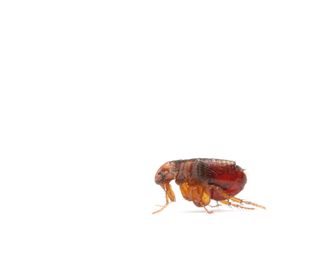
Know the signs of a flea infestation
Figuring out how to get rid of fleas starts with knowing the signs to look out for.
The fleas that occasionally invade our homes tend to be cat and dog fleas – it's very unlikely that you'll find human fleas. So, the good news is that you're most likely to spot fleas because of your pet's behaviour, rather than because you yourself are infested.
The biggest tell-tale sign is that your dog or cat might be scratching or biting its fur or fidgeting constantly. This is a good time to have a look at your pet to see if you can spot the fleas – or rule out a skin infection.
Martha Stewart explains more, 'For many pets, flea bites cause only slight skin irritation. Other animals have a more severe reaction, which can include hair loss, lesions, and ulcers. A serious infestation can trigger anemia, especially in puppies and kittens. Fleas may also carry infectious diseases and parasites such as tapeworm.'
If you can't see any fleas on your pet, have a good look around the places they like to lie down, perhaps their beds or a particular spot on the sofa.
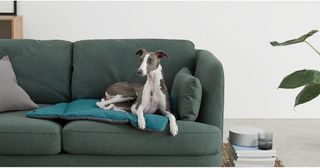
How to get rid of fleas in the home
1. Start by vacuuming the furniture – soft furnishings like cushions, mattresses and upholstery are the perfect refuge for fleas.
2. Take everything outside that you can, well away from the house and shake it out into the garden.
3. Hot wash everything you can. That goes for soft furnishings and any clothes that are in or have been in the room affected. Wash your bed linen, mattress protector, and pets’ bed linen on the hottest wash recommended, too.
4. Thorough vacuuming is key to getting the fleas out of carpets and rugs. It can remove a good proportion of flea larvae and flea eggs. Make sure you go right up to the edges of the room when you vacuum as this is where they can lurk. You’ll also need to vacuum right under all your furniture, too.
5. Don't stop at soft furnishings: although your carpet, sofa or bed might be where you first spotted the fleas, you’ll need to do the same with wooden flooring (fleas can infest the gaps).
6. Move on to gaps! Any gaps between skirting boards and walls, cracks in walls... they're all worth your attention.
7. Get the right kit and use it right: a pet vacuum will do a top job, but make sure you empty it after each vacuuming session, disposing of the sealed vacuum cleaner bag in the bin outside, not in your interior. Got a bagless cleaner? Empty the dirt cylinder into a bag outside, tie the bag closed, and put the bag in the bin out there.
8. Treat your home with a flea spray that will kill remaining fleas and their eggs. Always follow the instructions explicitly, including those on how long you need to exclude pets and children from the room you are treating, and on ventilating the room afterwards. (Try our favorite flea spray, below).
- Never sleeping again and would rather just throw your mattress in the trash? Shop for a new one in our tried-and-tested guide on the best mattress.
This is our favourite flea spray for your home (it works)
The Realhomes.com team has a ton of pets between them (well a few kgs' worth, anyway) and flea infestations aren't unknown at Realhomes Towers.
We've used and recommend Virbac Indorex Defence Household Flea Spray; it's a vet-recommended product which kills adult fleas and stops development of eggs and larvae. It promises to get rid of adult fleas – and house dust mites – on contact for up to two months after application, and prevent the development of flea eggs and larvae for up to 12 months.
Spray the carpet, plus other surfaces according to instructions, and don't neglect skirting boards and underneath rugs. Ventilate the room as indicated afterwards. You’ll need to vacuum your rooms for seven consecutive days after treatment as well.
Warning: You’ll need to shut doors and windows before you use it, and keep pets out.
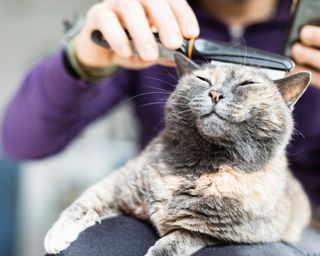
How to get rid of fleas on pets
If you think your pet has brought in the fleas to your home, you should inspect and treat your pet as soon as possible. Here are the best ways to do this:
1. Wash you pet with an effective flea shampoo containing contain pyrethrin. Go with one recommended by your vet to make sure it's the best option for your pet.
2. Buy a flea comb and use with soapy water to remove the critters from your pet's fur and drown them in the soapy water.
3. Wash your pet's bedding in hot water every couple of days and dry on the hottest cycle. Or purchase them a brand new pet mattress to make sure the critters are gone for good.
4. Get your vet's advice on the best topical flea treatments that are safe for pets. Try to avoid shop bought flea treatments if you can.
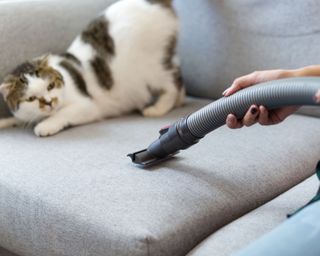
The best vacuums for pets (and to get rid of fleas)
DYSON LIGHT BALL ANIMAL UPRIGHT VACUUM CLEANER
Dyson is known for its powerful vacuums, and the Animal is no exception. If you have pets, then this is regarded as one of the best vacuums you can buy.
Since Dyson is known not only for suction power but also filter simplicity, this is the best vacuum easy cleaning of pet hair. You can suck up all kinds of pet hair without worry of blockage or leave stray hairs due to a lack of power. The attachment options also make cleaning a pet bed a simple task too.
MIELE COMPLETE C3 CAT & DOG VACUUM CLEANER
This specialised vacuum for pets by Miele is designed for those who tend to suffer with allergies, particularly to dust and pet hair; making this the best vacuum for allergies to pets.
SHARK DUOCLEAN CORDED STICK VACUUM
If you don’t want to lug around a big and bulky vacuum (who does?), then the Shark DuoClean Vacuum is lightweight and easy to manoeuvre, plus its thin body makes it easy to store. In fact this is one of the best vacuums for quick pet hair cleaning.
- Read more about the best vacuums for pet hair in our in-depth buyer's guide.

How to get rid of fleas with home remedies
There are tons of home remedies associated with getting rid of fleas – from making a flea trap out of hot soapy water and putting it where you've seen fleas (perhaps in your dog's bed or on the sofa, for example) to sprinkling the sofa/carpet/dog bed with bicarbonate of soda, salt, ground rosemary or lemon then vacuuming.
However, it's unlikely that any element of these remedies work if the infestation seems uncontrollable, other than the vacuuming.
Martha Stewart shares her views, 'From apple cider vinegar to brewer's yeast to rosemary water, there are a ton of "natural" flea remedies floating around the Internet and pet-store shelves. While some may be effective, they're not always the best way to protect your pet.'
We'll highlight the home remedies we think you could give a whirl if the infestation is a mild one.
Martha Stewart's flea natural remedies hacks
Martha Stewart shares her go-to home remedies to try:
'Consider adding beneficial nematodes (microscopic worms that feed on young fleas) to your yard.'
'You can also sprinkle diatomaceous earth—a natural substance that causes fleas and ticks to dehydrate and die—indoors and out (look for it at pet stores).'
'For fleas, a repellent spray that's made from herbal or food-based ingredients is one of the safest methods of direct intervention.'

Rosemary for light flea infestations
Rosemary can be used to treat light infestations in your home and on pets.
Healthline recommend the following to use on your pet:
'If you prefer natural remedies, make a strong solution by adding two cups of rosemary leaves to hot water. Allow the mixture to cool down and use it to spray, rinse, or soak your pet.'
You can also make a herbal flea powder. Here's how:
- Thinking of growing rosemary? Find more on growing a herb garden in our guide.
- Grind rosemary, wormwood, fennel and peppermint into a powder in a pestle and mortar.
- Sprinkle it on your carpets, furniture, pet bedding, window sills and anywhere else you suspect flea activity in your home.
Join our newsletter
Get small space home decor ideas, celeb inspiration, DIY tips and more, straight to your inbox!
Lucy is Global Editor-in-Chief of Homes & Gardens having worked on numerous interiors and property titles. She was founding Editor of Channel 4’s 4Homes magazine, was Associate Editor at Ideal Home, before becoming Editor-in-Chief of Realhomes.com in 2018 then moving to Homes & Gardens in 2021. She has also written for Huffington Post, AOL, UKTV, MSN, House Beautiful, Good Homes, and many women’s titles. Find her writing about everything from buying and selling property, self build, DIY, design and consumer issues to gardening.
